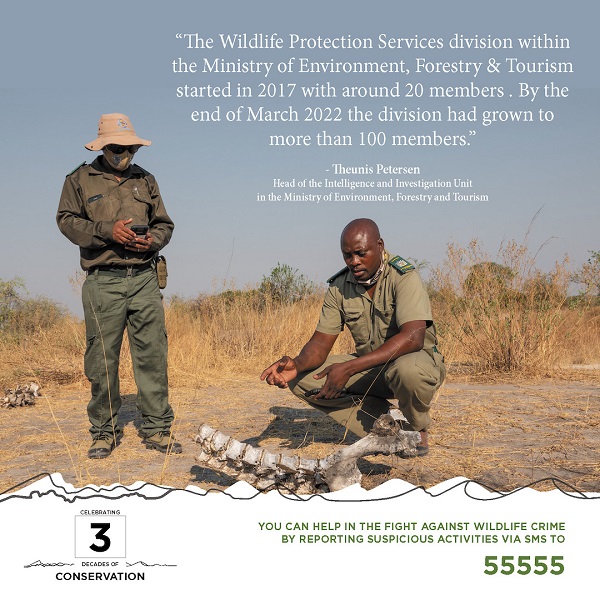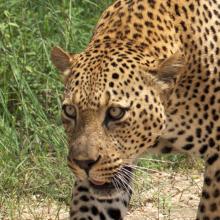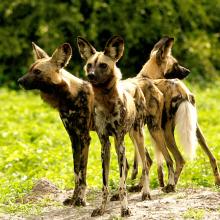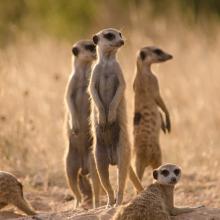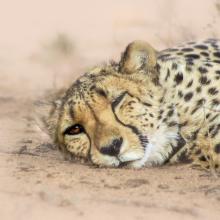
NCWG
Namibian Carnivore Working Group (NCWG)
About
The Namibian Carnivore Working Group (NCWG) is composed of individuals and organisations that work alongside the Ministry of Environment, Forestry and Tourism (MEFT) to promote and support the long-term conservation of healthy populations of free-ranging carnivores in Namibia.
NCWG was established in 2022 following the publication of Namibia’s Red Data Book on Terrestrial Carnivores to help implement a set of strategies and actions to promote carnivore conservation in Namibia. It brings together the Ministry of Environment, Forestry and Tourism, the environmental non-governmental sector (NGOs) working on terrestrial carnivores, farmers, conservancies, privately protected areas, academia, hunters, and other interested individuals and organisations. It is anticipated that the Large Carnivore Management Association of Namibia (LCMAN) which comprises members from sectors other than government, will evolve into the NCWG, with the collective aim to conserve the carnivores of Namibia, particularly those under the greatest pressure.
NCWG Members
Chair:
Ministry of Environment, Forestry and Tourism, represented by Kenneth /Uiseb and/or Muzuma Uakendisa.
Secretariat:
Lauren Pfeiffer lauren@cheetah.org
If you are interested in joining NCWG please contact the Secretariat. Membership is free.
Member Organisations:
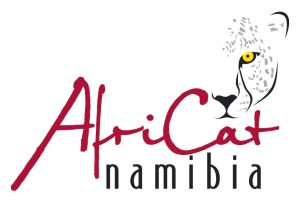
Africat Foundation
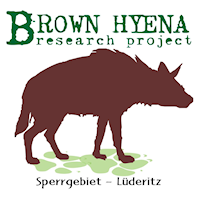
Brown Hyena Research Project Trust Fund
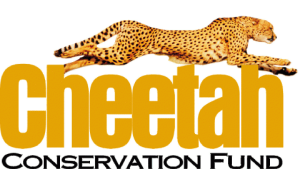
Cheetah Conservation Fund
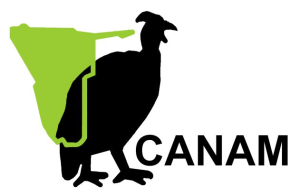
Conservancies Association of Namibia (CANAM)
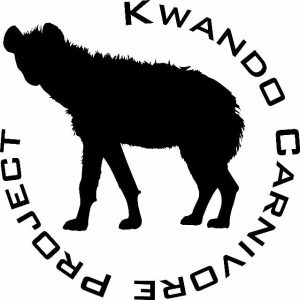
Kwando Carnivore Project (Lise Hanssen)
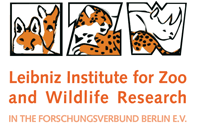
Leibniz Institute for Zoo and Wildlife Research
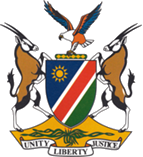
Ministry of Environment, Forestry and Tourism

N/a’an ku sê Foundation

Namibia Agricultural Union
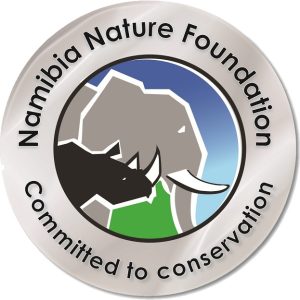
Namibia Nature Foundation
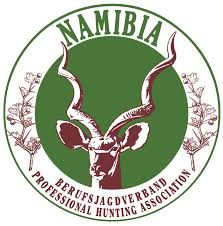
Namibia Professional Hunting Association

Namibian Chamber of Environment

Namibian Lion Trust

NamibRand Nature Reserve

Ongava Game Reserve/ Research Centre

Orange River-Karoo Conservation Area (ORKCA)
Individual Members:
Activities
The Namibian Carnivore Working Group activities support the identified actions which can help to mitigate the threats which Namibia’s carnivores face.
The first working group meeting was held in December 2022.
Expectations:
- The WG provides a conducive platform to meet, discuss, plan, collaborate and find solutions
- A platform to share and learn from each other, to set priorities and align outcomes
- A forum to give technical presentations on research findings, effectiveness of management actions and assessment of priorities
- An institutional mechanism to work with MEFT to collectively address national and local conservation and management priorities, and focus research to fill key information gaps
- A forum to share information on all people / institutions issued with research permits working on carnivores who are not part of this WG
- The members and potential members of the WG constitute a valuable set of resources, skills and commitment for carnivore conservation in Namibia – not currently fully utilised but committed to contribute even more
- That the WG and its members will provide continuity in partner collaboration and in addressing challenges in the medium to long-term.
Progress to date:
Despite the fact that the Carnivore WG is just starting, there are a number of tangible outputs already in place and upon which the WG can build:
- Carnivore Red Data Book – baseline data, threats identified, actions suggested (see Resources)
- Poster summarising the above (see Resources)
- Website as a tool to share information and facilitate the work of the WG
- Article in the 2022 Conservation and Environment in Namibia magazine
- MSc bursaries made available by NCE for priority projects identified from information needs in Carnivore RDB. First student at UNAM is currently writing up her study on otters in northern rivers. A further two or three bursaries are on offer for similar work through UNAM and NUST.
Resources
Red Data book and poster
Conservation Status and Red List of the Terrestrial Carnivores of Namibia: Book and Poster. These can be downloaded from the EIS eLibrary.
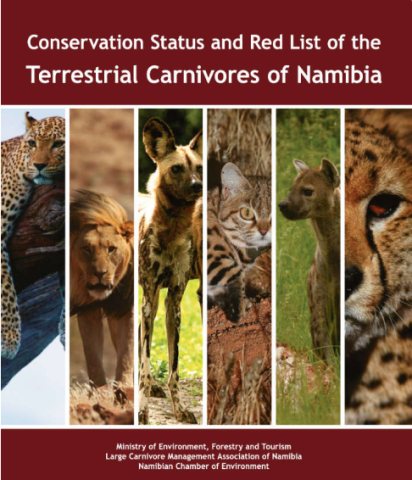
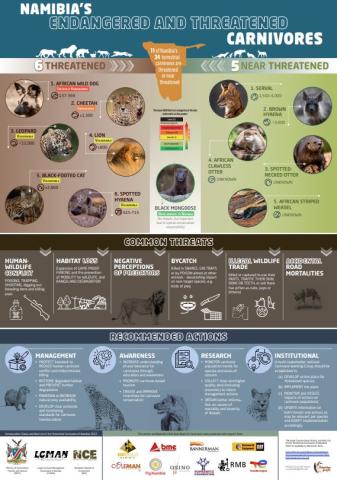
Other resources
Castro-Prieto A et al. 2011. Cheetah paradigm revisited: MHC diversity in the world’s largest free-ranging population. Molecular Biology and Evolution 28(4): 1455-1468. https://doi.org/10.1093/molbev/msq330. Download this resource from the EIS eLibrary
Castro-Prieto A et al. 2011. Diversity and evolutionary patterns of immune genes in free-ranging Namibian leopards (Panthera pardus pardus). Journal of Heredity 102(6): 653-665. https://doi.org/10.1093/jhered/esr097. Download this resource from the EIS eLibrary
Castro-Prieto A et al. 2012. Immunogenetic variation and differential pathogen exposure in free-ranging cheetahs across Namibian farmlands. PLoS ONE 7 (11): 1-19. https://doi.org/10.1890/ES12-00357.1. Download this resource from the EIS eLibrary
Costantini D et al. 2017. Socioecological and environmental predictors of physiological stress markers in a threatened feline species. Conservation Physiology 5(1). https://doi.org/10.1093/conphys/cox069. Download this resource from the EIS eLibrary
Durant SM et al. 2016. The global decline of cheetah Acinonyx jubatus and what it means for conservation. PNAS 114 (3): 528-533. https://doi.org/10.1073/pnas.1611122114. Download this resource from the EIS eLibrary
Edwards S et al. 2018. Coping with intrasexual behavioral differences: Capture– recapture abundance estimation of male cheetah. Ecology and Evolution 8(18): 9171-9180. https://doi.org/10.1002/ece3.4410. Download this resource from the EIS eLibrary
Edwards S et al. 2018. Making the most of by-catch data: Assessing the feasibility of utilising non-target camera trap data for occupancy modelling of a large felid. African Journal of Ecology 56(4): 885-894. https://doi.org/10.1111/AJE.12511. Download this resource from the EIS eLibrary
Edwards S et al. 2018. The spotted ghost: Density and distribution of serval Leptailurus serval in Namibia. African Journal of Ecology 56 (4): 831-840. https://doi.org/10.1111/aje.12540. Download this resource from the EIS eLibrary
Edwards S et al. 2019. Evidence of a high-density brown hyena population within an enclosed reserve: the role of fenced systems in conservation. Mammal Research 64: 519–527. https://doi.org/10.1007/s13364-019-00432-7. Download this resource from the EIS eLibrary
Edwards S et al. 2019. First confirmed record of infanticide for wild brown hyena. African Journal of Ecology 58 (3): 534-536. https://doi.org/10.1111/aje.12723. Download this resource from the EIS eLibrary
Edwards S et al. 2020. Socioecology of a high-density brown hyaena population within an enclosed reserve. Mammal Research 65: 223-233. https://doi.org/10.1007/s13364-020-00477-z. Download this resource from the EIS eLibrary
Edwards S et al. 2022. Cheetah marking sites are also used by other species for communication: evidence from photographic data in a comparative setup. Mammalian Biology https://doi.org/10.1007/s42991-022-00284-w. Download this resource from the EIS eLibrary
Weyrich A et al. 2022. First steps towards the development of epigenetic biomarkers in female cheetahs (Acinonyx jubatus). Life 12(6): 920. https://doi.org/10.3390/life12060920. Download this resource from the EIS eLibrary
Fischer H et al. 2022. A preliminary comparison of brown hyaena activity patterns at den sites located within a protected reserve and a commercial farmland. Namibian Journal of Environment 6B: 1-5. Download this resource from the EIS eLibrary
Frigerio D et al. 2018. Citizen science and wildlife biology: Synergies and challenges. Ethology 124 (6): 365-377. https://doi.org/10.1111/eth.12746. Download this resource from the EIS eLibrary
Giese L et al. 2021. Using machine learning for remote behaviour classification—verifying acceleration data to infer feeding events in free-ranging cheetahs. Sensors 21(16): 5426. https://doi.org/10.3390/s21165426. Download this resource from the EIS eLibrary
Government Gazette of the Republic of Namibia, No. 7912, 28 September 2022. Government Notice No. 278: Regulations relating to keeping of large carnivores in captivity: Nature Conservation Ordinance, 1975. Download this resource from the EIS eLibrary
Heinrich S et al. 2017. Cheetahs have a stronger constitutive innate immunity than leopards. Sci Rep 7. https://doi.org/10.1038/srep44837. Download this resource from the EIS eLibrary
Heinrich SK et al. 2016. Benign pigmented dermal basal cell tumor in a Namibian cheetah (Acinonyx jubatus). Case Reports in Veterinary Medicine. https://doi.org/10.1155/2016/7981765. Download this resource from the EIS eLibrary
Heinrich SK et al. 2016. Feliform carnivores have a distinguished constitutive innate immune response. Biology Open 5 (5): 550–555. https://doi.org/10.1242/bio.014902. Download this resource from the EIS eLibrary
Johnson S et al. 2013. Modeling the viability of the free-ranging cheetah population in Namibia: an object-oriented Bayesian network approach. Ecosphere 4(7): 1-19. https://doi.org/10.1890/ES12-00357.1. Download this resource from the EIS eLibrary
Kambongi T et al. 2021. A description of daytime resting sites used by brown hyaenas (Parahyaena brunnea) from a high-density, enclosed population in north-central Namibia. Namibian Journal of Environment 5B: 1-6. Download this resource from the EIS eLibrary
Klein K et al. 2021. Visual analytics of sensor movement data for cheetah behaviour analysis. Journal of Visualization 24: 807–825. https://doi.org/10.1007/s12650-021-00742-6. Download this resource from the EIS eLibrary
Krengel A et al. 2015. Gammaretrovirus-specific antibodies in free-ranging and captive Namibian cheetahs. Clinical and Vaccine Immunology 22(6): 611-617. https://doi.org/10.1128/CVI.00705-14. Download this resource from the EIS eLibrary
Krücken J et al. 2021. Genetic diversity of vector-borne pathogens in spotted and brown hyenas from Namibia and Tanzania relates to ecological conditions rather than host taxonomy. Parasites Vectors 14: 328. https://doi.org/10.1186/s13071-021-04835-x. Download this resource from the EIS eLibrary
Melzheimer J et al. 2018. Queuing, takeovers, and becoming a fat cat: Long-term data reveal two distinct male spatial tactics at different life-history stages in Namibian cheetahs. Ecosphere 9 (6). https://doi.org/10.1002/ecs2.2308. Download this resource from the EIS eLibrary
Melzheimer J et al. 2022. Communication hubs of an asocial cat are the source of a human–carnivore conflict and key to its solution. Proceedings of the National Academy of Sciences 117 (52). https://doi.org/10.1073/pnas.2002487117. Download this resource from the EIS eLibrary
Menke S et al. 2022. Oligotyping reveals differences between gut microbiomes of free-ranging sympatric Namibian carnivores (Acinonyx jubatus, Canis mesomelas) on a bacterial species-like level. Frontiers in Microbiology 5. https://doi.org/10.3389/fmicb.2014.00526. Download this resource from the EIS eLibrary
Menke S et al. 2017. Effects of host traits and land-use changes on the gut microbiota of the Namibian black-backed jackal (Canis mesomelas). FEMS Microbiology Ecology 93(11). https://doi.org/10.1093/femsec/fix123. Download this resource from the EIS eLibrary
NCE Press Release, 12 September 2022: Publication of Conservation Status and Red List of the Terrestrial Carnivores of Namibia. Go to this link
Noack J et al. 2019. Leopard density estimation within an enclosed reserve, Namibia using spatially explicit capture-recapture models. Animals 2019 (9): 724. https://doi.org/10.3390/ani9100724. Download this resource from the EIS eLibrary
Paijmans JLA et al. 2021. African and Asian leopards are highly differentiated at the genomic level. Current Biology 31(9): 1872-1882. https://doi.org/10.1016/j.cub.2021.03.084. Download this resource from the EIS eLibrary
Portas R et al. 2021. GPS telemetry reveals a zebra with anthrax as putative cause of death for three cheetahs in the Namib Desert. Frontiers in Veterinary Science 8. https://doi.org/10.3389/fvets.2021.714758. Download this resource from the EIS eLibrary
Portas R et al. 2022. Leopard Panthera pardus camera trap surveys in the arid environments of northern Namibia. Mammalian Biology. https://doi.org/10.1007/s42991-022-00237-3. Download this resource from the EIS eLibrary
Richmond-Coggan L. 2019. The Namibian leopard: National census and sustainable hunting practices. Report for Namibian Professional Hunting Association (NAPHA) and the Ministry of Environment and Tourism (MET). Download this resource from the EIS eLibrary
Schares G et al. 2021. Molecular analysis suggests that Namibian cheetahs (Acinonyx jubatus) are definitive hosts of a so far undescribed Besnoitia species. Parasites Vectors 14: 201. https://doi.org/10.1186/s13071-021-04697-3. Download this resource from the EIS eLibrary
Seltman A et al. 2020. Species-specific diferences in Toxoplasma gondii, Neospora caninum and Besnoitia besnoiti seroprevalence in Namibian wildlife. Parasites Vectors 13: 7. https://doi.org/10.1186/s13071-019-3871-3. Download this resource from the EIS eLibrary
Stein A et al. 2011. Namibian national leopard survey. Download this resource from the EIS eLibrary
Stein AB et al. 2011. Leopard population and home range estimates in north-central Namibia. Journal of Ecology 49 (3): 383-387. https://doi.org/10.1111/j.1365-2028.2011.01267.x. Download this resource from the EIS eLibrary
Thalwitzer S et al. 2010. Seroprevalences to viral pathogens in free-ranging and captive cheetahs (Acinonyx jubatus) on Namibian farmland. Clinical and Vaccine Immunology 17(2): 232-238. https://doi.org/10.1128/CVI.00345-09. Download this resource from the EIS eLibrary
Tordiffe ASW et al. 2016. Comparative serum fatty acid profiles of captive and free-ranging cheetahs (Acinonyx jubatus) in Namibia. PLoS ONE 12. https://doi.org/10.1371/journal.pone.0167608. Download this resource from the EIS eLibrary
Turner WC et al. 2022. Africa’s drylands in a changing world: Challenges for wildlife conservation under climate and land-use changes in the Greater Etosha Landscape. Global Ecology and Conservation 38: 1-24. https://doi.org/10.1016/j.gecco.2022.e02221. Download this resource from the EIS eLibrary
Voigt CC et al. 2013. A breath test to assign carnivore diets to browsers or grazers. Wildlife Biology 19(3): 311-316. https://doi.org/10.2981/13-012. Download this resource from the EIS eLibrary
Voigt CC et al. 2018. Sex-specific dietary specialization in a terrestrial apex predator, the leopard, revealed by stable isotope analysis. Journal of Zoology 306(1): 1-7. https://doi.org/10.1111/jzo.12566. Download this resource from the EIS eLibrary
Voigt CC et al. 2014. The conflict between cheetahs and humans on Namibian farmland elucidated by stable isotope diet analysis. PLOS ONE 9(8): e101917. https://doi.org/10.1371/journal.pone.0101917. Download this resource from the EIS eLibrary
Wachter B et al. 2010. Reproductive history and absence of predators are important determinants of reproductive fitness: the cheetah controversy revisited. Conservation Letters 4: 47-54. https://doi.org/10.1111/j.1755-263X.2010.00142.x. Download this resource from the EIS eLibrary
Wachter B et al. 2012. An advanced method to assess the diet of free-ranging large carnivores based on scats. PLoS ONE 7(6): e38066. https://doi.org/10.1371/journal.pone.0038066. Download this resource from the EIS eLibrary
Wasimuddin et al. 2017. Gut microbiomes of free-ranging and captive Namibian cheetahs: Diversity, putative functions and occurrence of potential pathogens. Molecular Ecology 26(20): 5515-5527. https://doi.org/10.1111/mec.14278. Download this resource from the EIS eLibrary
Weise FJ et al. 2017. The distribution and numbers of cheetah (Acinonyx jubatus) in southern Africa. PeerJ 5:e4096. https://doi.org/10.7717/peerj.4096. Download this resource from the EIS eLibrary
Namibia’s carnivores
Overview
Namibia has 34 species of terrestrial carnivores. Eleven of these are either Threatened (six species) or Near Threatened (five species). These are, starting with species under the greatest threat: African Wild Dog (Critically Endangered), Cheetah (Endangered), Black-footed Cat, Leopard, Lion and Spotted Hyaena (Vulnerable); Serval, Brown Hyaena, African Clawless Otter, Spotted-necked Otter and African Striped Weasel (Near Threatened). The other 23 terrestrial carnivore species are considered to be of “Least Concern”, meaning that their conservation status is currently considered to be secure. One species, the Black Mongoose, is near endemic to Namibia. This means that most of its population occurs in Namibia, and we have a special responsibility for its long-term welfare.
Identification, status, photos and distributions
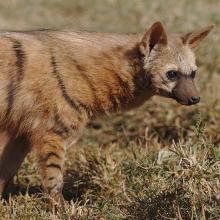
Aardwolf
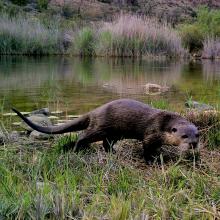
African Clawless Otter
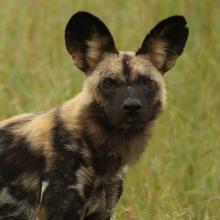
African Wild Dog
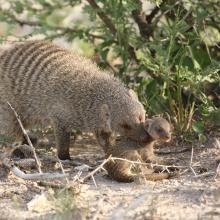
Banded Mongoose
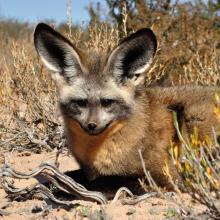
Bat-eared Fox

Black Mongoose
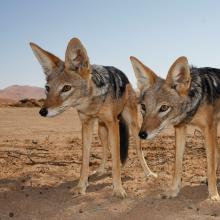
Black-backed Jackal
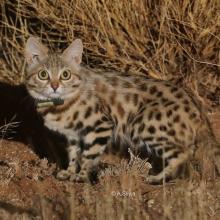
Black-footed Cat
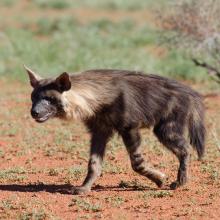
Brown Hyaena
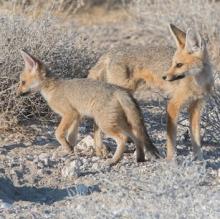
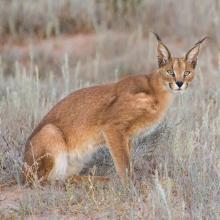
Caracal
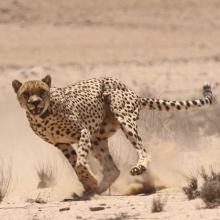

Civet
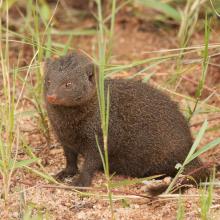
Dwarf Mongoose
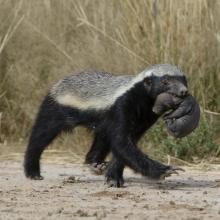
Honey Badger
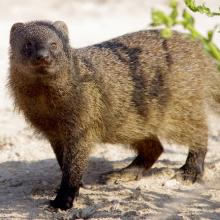
Large Grey Mongoose
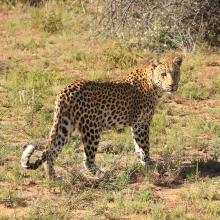

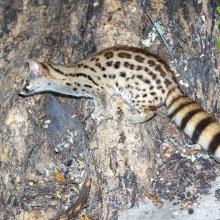
Rusty-spotted Genet
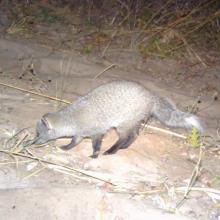
Selous' Mongoose
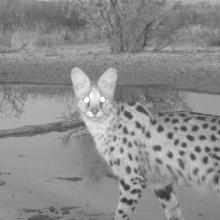
Serval
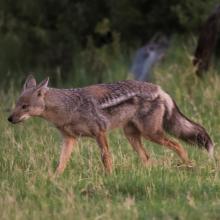
Side-striped Jackal
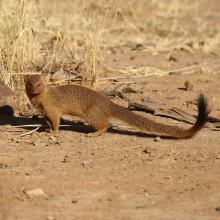
Slender Mongoose
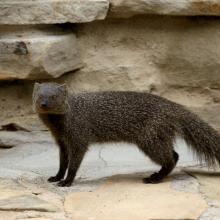
Small Grey Mongoose
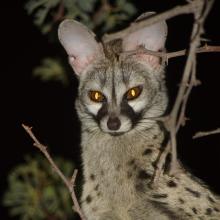
Small-spotted Genet
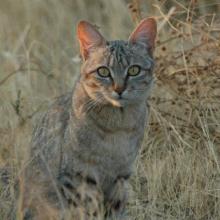
Southern African Wild Cat
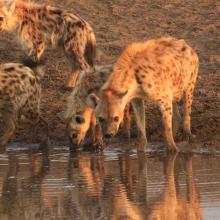
Spotted Hyaena

Spotted-necked Otter
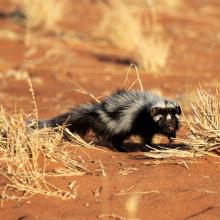
Striped Polecat, or Zorilla
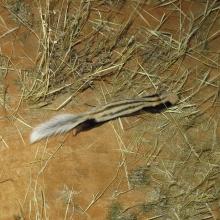
Striped Weasel
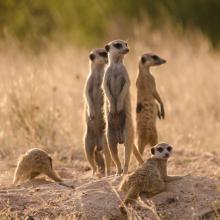
Suricate
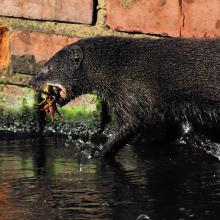
Water Mongoose
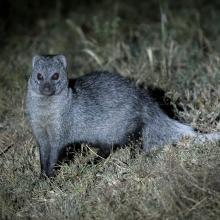
White-tailed Mongoose
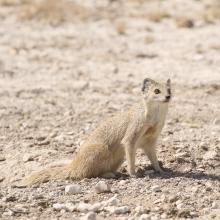
Yellow Mongoose
Threats & Actions
Threats to Namibia’s carnivores
A number of common threats are faced by many terrestrial carnivore species in Namibia, as well as threats specific to particular species based on their habitat and ecology. The most significant common threats are:
- Human-wildlife conflict, when carnivores are deliberately killed or targeted in response to real, perceived or anticipated damages caused or expected to be caused. The most common methods used to kill predators are poisoning, trapping, shooting, and digging out breeding dens to kill the young. A number of these methods are very indiscriminate, resulting in many hundreds of non-target animals and species being killed, such as vultures, eagles and kites. They are also largely ineffective, sometimes adding to the problem by disrupting stable populations and opening the area to subadult animals that cause a worse problem, and severely impacting on biodiversity and ecosystem health. Best farming practices focus on protecting livestock, not killing predators.
- Habitat loss, fragmentation and degradation. A particularly concerning trend is the expansion of game-proof and electric fencing across the country which fragments the landscape and prevents mobility for wildlife generally which is their most important adaptation to an arid environment.
- Bycatch or collateral killing, when non-target species such as Black-footed Cat, genets and mongooses (as well as non-carnivore species) are killed instead of the target individual or species. The most indiscriminate forms of predator control are poisons, snares and gin traps. These methods need to be outlawed. Poisons have a particularly devastating impact on non-target species, particularly birds of prey. It has been estimated that for every individual of a target species killed, over 100 non-target animals are poisoned.
- Species killed or captured deliberately to use their parts, traffic their skin, bone, teeth, or sell their young live in the illegal wildlife trade.
Actions
By addressing these common threats, positive outcomes can be achieved for most species. The priority actions arising from the Carnivore Red Data Book are:
- Establish this multi-stakeholder national Carnivore Working Group to –
- Develop strategies and action plans for all threatened species
- Form species specific task forces to raise funds and implement the strategies and plans
- Monitor and assess impacts of actions on the status of carnivore populations
- Update information on both threats and actions as relevant per species and adapt implementation accordingly.
- Assist farmers to improve rangeland and livestock management, and especially –
- Focus on the protection of livestock and not on the killing of predators, as this delivers far better and most cost-effective outcomes and healthy ecosystems
- Restore and regenerate rangeland through good management that builds soil carbon, perennial grasses and good grass-bush/tree ratios
- Build and maintain wildlife biodiversity so that there is sufficient natural prey available to predators
- Develop and implement clear protocols for dealing with persistent predators problems.
- Design and implement a national carnivore awareness programme that is targeted at specific sectors and supported by all members of the NCWG to –
- Increase understanding of the important role of carnivores in ecosystems and to improve farmer tolerance and appreciation of carnivores on their land
- Work with the tourism sector, conservancies and wildlife credit programmes to incentivise carnivore-based tourism with benefits to farmers / conservancies to help offset costs of living with these animals
- Work with farmers and hunters to optimise benefits to landowners and custodians from sustainable use of selected carnivore species.
- Develop a national research framework for carnivores to –
- Monitor carnivore population status, distribution and trends for all carnivores, but with a special focus on threatened species and high-risk areas
- Collect more and higher quality data, including economic data, to better inform management actions
- Obtain better time-series information on causes of mortality, the severity of threats and appropriate responses.
How can you help?
Help to support the identified actions which can help to mitigate the threats which Namibia’s carnivores face. Get in touch if you need advice over the phone about any carnivores you might have on your farm, livestock predation and mitigation methods or further information about carnivore ecology. If necessary, staff can visit your farm to provide a detailed of your farm and problem carnivore. NCWG does not promote the killing of carnivores, but instead promotes sustainability and co-existence with carnivores and livestock farming.
Get advice if you notice unusual activity such as:
- Increased activity of carnivores around kraals
- Higher levels of livestock loss from predators than previous years
- Any abnormal behaviour
- Solitary when should be within a group/pack
- Subdued behaviour
- Obvious signs the carnivore is limping or injured.
These behaviours could be a sign the carnivore is sick or injured and may be unable to hunt normally. Further assessment of the situation can be provided by phoning the NCWG Secretariat.
Record your sightings of carnivores on the Atlasing in Namibia website or the Atlasing in Namibia app.
Contact
Namibian Carnivore Working Group
Secretariat: lauren@cheetah.org
The Ministry of Environment, Forestry and Tourism, as well as several of the Namibian Carnivore Working Group member organisations will happily provide you with free advice over the phone about any carnivores you might have on your farm, livestock predation and mitigation methods or further information about carnivore ecology. If necessary, staff can visit your farm to provide a detailed of your farm and problem carnivore. NCWG does not promote the killing of carnivores, but instead promotes sustainability and co-existence with carnivores and livestock farming.
Get advice if you notice unusual activity or behaviours that could be a sign the carnivore is sick or injured and may be unable to hunt normally.
National Wildlife Crime Hotline
Report suspicious activity to the National Wildlife Crime Hotline by sending an sms to 55555.
